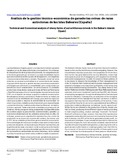| dc.rights.license | http://creativecommons.org/licenses/by-nc-sa/3.0/ve/ | es_VE |
| dc.contributor.author | Mena, Yolanda | |
| dc.contributor.author | Delgado–Pertiñez, Manuel | |
| dc.date.accessioned | 2024-03-01T04:24:19Z | |
| dc.date.available | 2024-03-01T04:24:19Z | |
| dc.date.issued | 2024 | |
| dc.identifier.issn | 0798-2259 | |
| dc.identifier.uri | http://www.saber.ula.ve/handle/123456789/50233 | |
| dc.description.abstract | Las Islas Baleares, España, poseen una importante tradición ganadera
basada en el uso de razas autóctonas y en el pastoreo. Sin embargo,
la intensificación de la producción primaria, la competencia por
el territorio generado por el turismo y su baja rentabilidad, hacen
que estos sistemas estén a punto de desaparecer, con negativas
consecuencias ambientales y sociales. Para poder conservar estos
sistemas, es necesario profundizar en el conocimiento del manejo,
lo que permitirá mejorar su gestión técnica y económica y establecer
estrategias que optimicen su rentabilidad, pero conservando sus
beneficios socio–ambientales. Se seleccionaron 10 unidades
productivas ovinas de dos razas autóctonas de Mallorca (Mallorquina
y Roja Mallorquina) que fueron monitorizadas mensualmente durante
2015, con el objetivo de evaluar la gestión mediante la elaboración
de indicadores técnico–económicos. Posteriormente, se realizó una
evaluación de las debilidades del manejo, para detectar aspectos
clave que ayuden a mejorar la rentabilidad de la actividad. Se
observó que estas unidades productivas están poco especializadas
y presentan diversos modelos productivos (profesional, recreativo,
turístico, agrícola). Todas ellas están orientadas a la producción de
corderos, menos una que es mixta, produciendo tres tipos diferentes
de corderos según su peso (lechal, recental medio y grande). La
autonomía alimentaria de las unidades productivas es alta, sin
embargo, poseen poca organización reproductiva y los costes de
producción no se cubren por el precio del cordero. Así mismo, solo
el 30 % de las unidades productivas genera beneficio empresarial.
Como estrategias de mejora se considera importante la mejora de la
producción de pastos; la mejora de la planificación reproductiva y de
la genética de las razas; el producir corderos de buena conformación
de la canal o el crear una marca de calidad que informe al consumidor
de los beneficios ambientales de estos sistemas y de la calidad
nutritiva–funcional que tienen estos corderos criados en pastoreo. | es_VE |
| dc.language.iso | es | es_VE |
| dc.publisher | SaberULA | es_VE |
| dc.rights | info:eu-repo/semantics/openAccess | es_VE |
| dc.subject | Razas ovinas autóctonas | es_VE |
| dc.subject | Ganadería de pastoreo | es_VE |
| dc.subject | Mallorquina | es_VE |
| dc.subject | Roja Mallorquina | es_VE |
| dc.subject | Sostenibilidad | es_VE |
| dc.title | Análisis de la gestión técnico–económica de ganaderías ovinas de razas autóctonas de las Islas Baleares (España) | es_VE |
| dc.title.alternative | Technical and Economical analysis of sheep farms of autochthonous breeds in the Balearic Islands (Spain) | es_VE |
| dc.type | info:eu-repo/semantics/article | es_VE |
| dc.description.abstract1 | The Balearic Islands, Spain, have an important livestock tradition
based on the use of autochthonous breeds and grazing. However, the
intensification of primary production, the competition for the territory
that tourism has generated and its low of profitability, means that
these systems are at risk of disappearing, with negative environmental
and social consequences. In order to conserve these systems, it
is necessary to deepen the knowledge of their management in
order to improve their technical and economic management and
establish strategies to increase their profitability, while conserving
their environmental and social benefits. Ten sheep farms of two
native Mallorcan breeds (Mallorquina and Roja Mallorquina) were
selected, which were monitored monthly during 2015, with the aim
of evaluating management through the development of technical and
economic indicators. Subsequently, an evaluation of the strengths
and weaknesses of this management has been carried out, to detect
key aspects that help improve the profitability of the activity. It was
observed that these farms are not very specialized and have different
production models (professional, recreational, tourist, agricultural).
All the farms are oriented to the production of lambs, except one
that is mixed, producing three different types of lambs according
to their weight (suckling, medium and large “recental”). The farms'
feed self–sufficiency is high, however, they have little reproductive
organization and production costs are not covered by the price of the
lamb. Likewise, only 30% of the farms generate business profit. As
improvement strategies, it was considered important to improve the
production of pastures, both natural and cultivated; improvement of
reproductive planning and breed genetics; producing lambs with a
good carcass conformation or creating a quality mark that informs
the consumer of the environmental benefits of these systems and
of the nutritional–functional quality of these pasture–raised lambs. | es_VE |
| dc.description.colacion | 1-7 | es_VE |
| dc.description.email | pertinez@us.es | es_VE |
| dc.identifier.depositolegal | pp199102ZU46 | |
| dc.identifier.edepositolegal | ppi201502ZU4665 | |
| dc.identifier.eissn | 2477-944X | |
| dc.publisher.pais | Venezuela | es_VE |
| dc.subject.institucion | Universidad del Zulia (LUZ) | es_VE |
| dc.subject.institucion | Universidad de Los Andes (ULA) | es_VE |
| dc.subject.keywords | Autochthonous sheep breeds | es_VE |
| dc.subject.keywords | Grazing farming | es_VE |
| dc.subject.keywords | Mallorquina | es_VE |
| dc.subject.keywords | Roja Mallorquina | es_VE |
| dc.subject.keywords | Sustainability | es_VE |
| dc.subject.publicacionelectronica | Revista Científica | |
| dc.subject.seccion | Revista Científica: Artículos | es_VE |
| dc.subject.thematiccategory | Medio Ambiente | es_VE |
| dc.subject.tipo | Revistas | es_VE |
| dc.type.media | Texto | es_VE |


